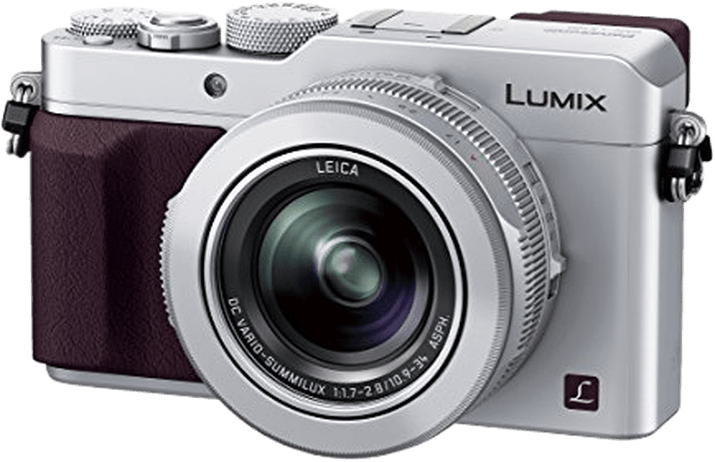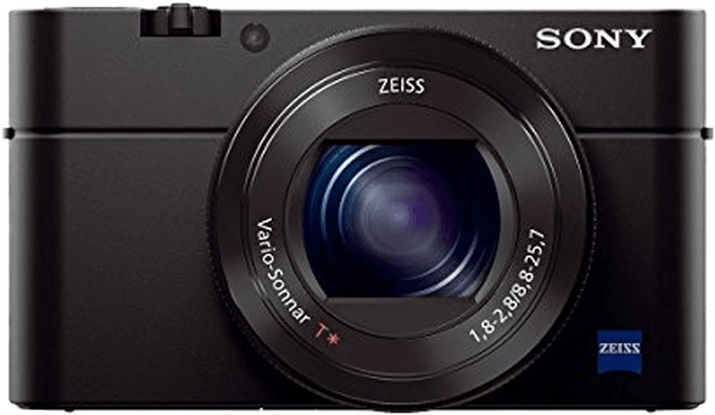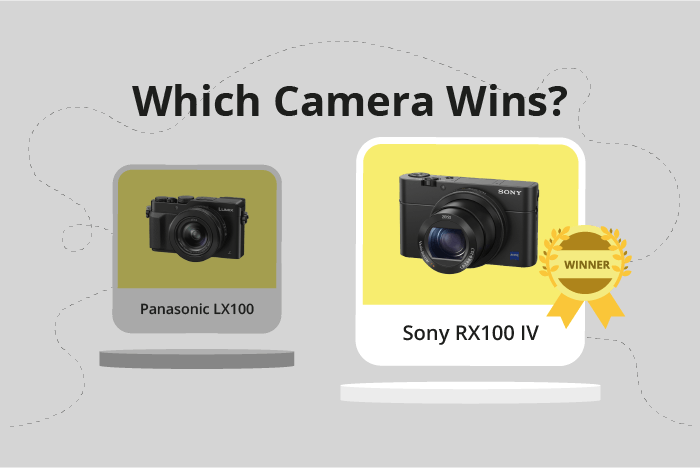Panasonic Lumix DMC-LX100 vs Sony Cyber-shot RX100 IV Comparison
Panasonic Lumix DMC-LX100

Sony Cyber-shot RX100 IV

The Sony Cyber-shot RX100 IV wins the comparison with a score of 64/100, while the Panasonic Lumix DMC-LX100 scores 49/100. Both cameras are compact, released in 2014 and 2015, with launch prices of $899 and $950, respectively. They share similar specifications, but the Sony RX100 IV outperforms the Panasonic LX100 in certain aspects.
The Sony RX100 IV is smaller (102 x 58 x 41mm) and lighter (298g), making it more portable and convenient for on-the-go photography. However, the Panasonic LX100 is not without its merits. It is slightly larger (115 x 66 x 55mm) and heavier (393g), which may provide a more comfortable grip for some users.
When considering these specifications, the Sony RX100 IV is the better choice for those prioritizing portability, while the Panasonic LX100 may suit those who prefer a larger and sturdier camera.
Panasonic Lumix DMC-LX100 vs Sony Cyber-shot RX100 IV Overview and Optics
The Sony Cyber-shot RX100 IV outperforms the Panasonic Lumix DMC-LX100 in optics, scoring 66/100 compared to the LX100’s 56/100. Both cameras share some common specifications, such as CMOS sensor types, fixed lens mounts, and image stabilization. However, the RX100 IV takes the lead in terms of key features.
The RX100 IV has a higher megapixel count (20) compared to the LX100 (12.8), resulting in sharper and more detailed images. Additionally, the RX100 IV boasts a faster shooting speed of 16 frames per second, while the LX100 has a shooting speed of only 11. The Bionz X processor in the RX100 IV also contributes to the camera’s superior performance. Furthermore, the RX100 IV’s sensor scores an impressive 82 in DXOMARK testing, compared to the LX100’s 67.
However, the LX100 has some advantages over the RX100 IV. Its Micro Four Thirds sensor size is larger than the RX100 IV’s 1″ sensor, which can result in better low-light performance and increased dynamic range. The LX100 also has a 4:3 aspect ratio, providing a more traditional format for photography compared to the RX100 IV’s 3:2 aspect ratio.
Taking these factors into consideration, the Sony Cyber-shot RX100 IV emerges as the superior camera in terms of optics. Its higher megapixel count, faster shooting speed, and better sensor performance contribute to its higher overall score. However, the Panasonic Lumix DMC-LX100 does not fall far behind, offering a larger sensor size and a more traditional aspect ratio that may appeal to some photographers.
Panasonic Lumix DMC-LX100 vs Sony Cyber-shot RX100 IV Video Performance
The Panasonic Lumix DMC-LX100 outperforms the Sony Cyber-shot RX100 IV in video capabilities, scoring 70/100 compared to the Sony’s 69/100. Both cameras share certain specifications, such as 4K max video resolution and 3840 x 2160 max video dimensions. However, there are key differences that set them apart.
The Panasonic LX100 has a built-in time-lapse functionality, giving it an advantage over the Sony RX100 IV, which lacks this feature. This allows the LX100 to capture stunning time-lapse videos with ease, making it a more versatile option for videographers.
On the other hand, the Sony RX100 IV has a higher max video frame rate of 60fps, whereas the Panasonic LX100 can only reach 30fps. A higher frame rate allows for smoother video playback and better slow-motion effects, giving the Sony RX100 IV an edge in this aspect.
Despite the Sony RX100 IV’s advantage in frame rate, the Panasonic LX100’s time-lapse feature gives it the edge in overall video capabilities. The one-point difference in their scores reflects the close competition between these two cameras. Both offer excellent 4K video quality, but the Panasonic LX100 caters more to those seeking creative time-lapse videos, while the Sony RX100 IV is better suited for smooth video playback and slow-motion effects.
Panasonic Lumix DMC-LX100 vs Sony Cyber-shot RX100 IV Features and Benefits
The Sony Cyber-shot RX100 IV outperforms the Panasonic Lumix DMC-LX100 in features, boasting a score of 70/100 compared to the latter’s 41/100. Both cameras share some common specifications, such as a 3-inch screen size, the absence of GPS, and the presence of WiFi connectivity. However, the RX100 IV surpasses the LX100 in several aspects, while the LX100 has fewer advantages.
The RX100 IV’s screen resolution is significantly higher at 1,228,800 dots, compared to the LX100’s 921,000 dots. Additionally, the RX100 IV has a touchscreen and Bluetooth connectivity, which the LX100 lacks. These features make the RX100 IV more versatile and user-friendly.
On the other hand, the LX100 has a flip screen, a feature that the RX100 IV also possesses. This is the only advantage of the LX100 over the RX100 IV. However, this shared feature does not compensate for the other areas in which the LX100 falls short.
Considering the differences in features, the Sony Cyber-shot RX100 IV is the clear winner in this comparison. Its higher screen resolution, touchscreen, and Bluetooth connectivity provide a better user experience and greater functionality. The Panasonic Lumix DMC-LX100, while having a flip screen, cannot compete with the RX100 IV’s superior features. Therefore, the RX100 IV is the better choice for those seeking a camera with more advanced features.
Panasonic Lumix DMC-LX100 vs Sony Cyber-shot RX100 IV Storage and Battery
The Panasonic Lumix DMC-LX100 and Sony Cyber-shot RX100 IV both score 16/100 for storage and battery. Each camera has one memory card slot and accepts SD, SDHC, and SDXC (UHS-I compatible) memory cards. Neither camera offers USB charging.
The Lumix DMC-LX100 has a slight advantage with its battery life, providing 300 shots per charge, compared to the RX100 IV’s 280 shots. Its battery type is DMW-BLG10E. However, the RX100 IV has an edge in memory card compatibility, also accepting Memory Stick Pro Duo and Pro-HG Duo cards, in addition to the standard cards. Its battery type is NP-BX1.
Although both cameras have their merits, the Lumix DMC-LX100’s longer battery life makes it a more reliable choice for extended shooting sessions. On the other hand, the RX100 IV’s additional memory card compatibility may be beneficial to users with existing Memory Stick Pro Duo or Pro-HG Duo cards. Ultimately, the choice depends on the photographer’s specific needs and preferences.
Alternatives to the Panasonic Lumix DMC-LX100 and Sony Cyber-shot RX100 IV
Are you still undecided about which camera is right for you? Have a look at these popular comparisons that feature the Panasonic Lumix DMC-LX100 or the Sony Cyber-shot RX100 IV:

